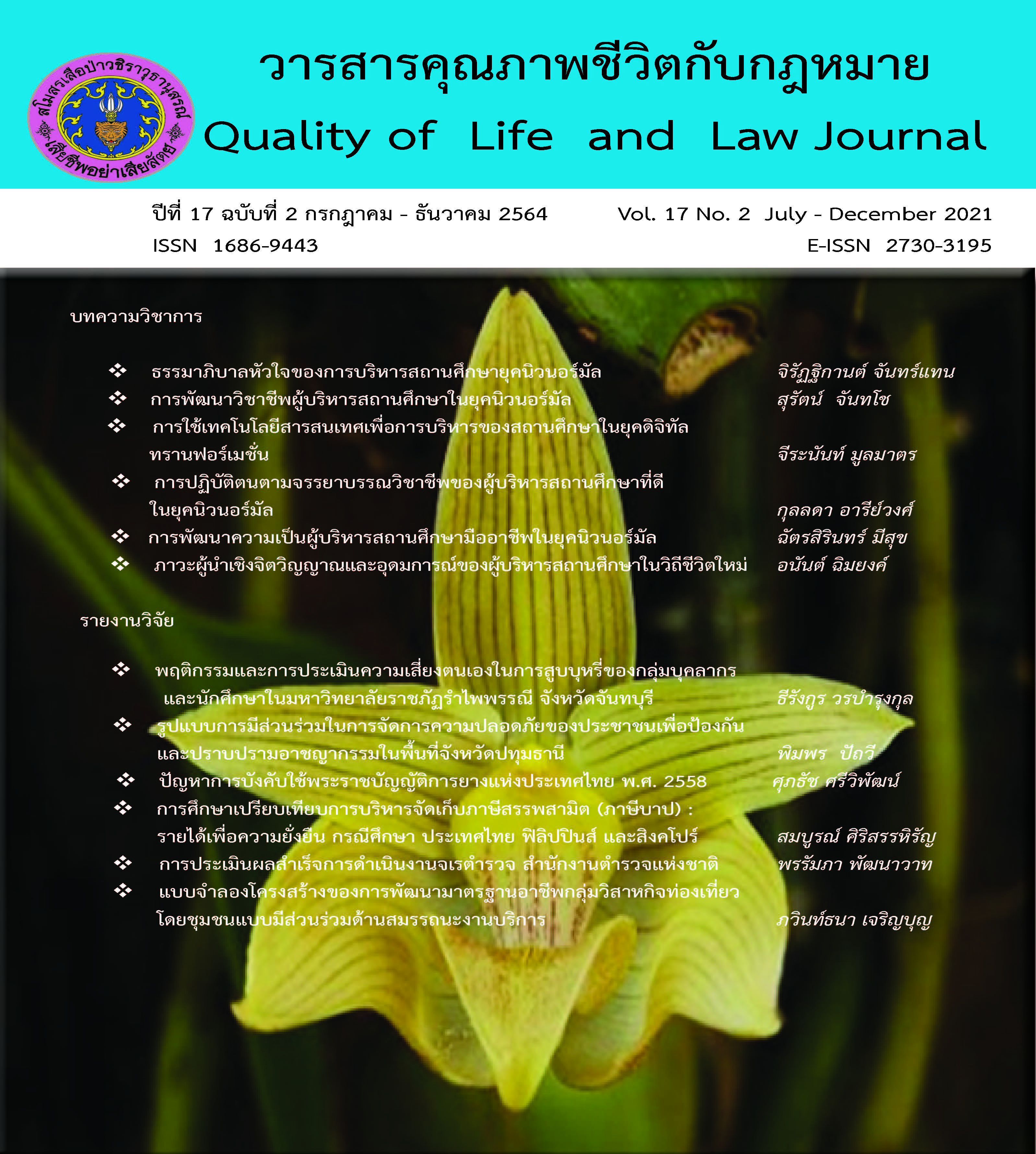Structural model of occupational standard development of community-based tourism enterprises with participation in service competency
Main Article Content
Abstract
This research aims to develop a structural model of the development of occupational standards of community-based tourism enterprises with participation in service performance. The researcher collected data with questionnaires. The sample group is tourists who come to travel in Mueang Phatthalung District. Phatthalung Province. A sample of 400 people. Using a specific sampling method. The statistics used are number, percentage, and path analysis.
The results of the research. Tourist attitudes towards external factors. Tourist attitudes towards tourism factors and behavior of tourists towards the marketing mix 34% of the model variance could be explained, wherein tourists' attitudes towards external factors and tourist behaviors on marketing mix have a positive influence and tourists' attitudes towards tourism factors have a negative influence towards the development of occupational standards of community-based tourism enterprises with participation in service performance. In the part of the structural model from adjusting the model Tested for conformance with empirical reference criteria. Chi-square Probability Level: CMIN-p = 17.405. Relative Chi-square: CMIN/df = 0.725. Goodness of Fit Index: GFI = .914. Root Mean Square Error of Approximation: RMSEA is equal to .002. The development of economic occupational standards should stipulate that tourism activities are conducted every month with other occupations. In parallel with tourism operations. The environment should create an understanding of sustainable tourism in the community. In terms of attractiveness, community strengths should be analyzed to create competitive opportunities. In terms of access to tourist attractions, relevant elements should be developed to facilitate tourists. In terms of marketing promotion, tourists should be analyzed in order to communicate appropriately. In the process, there should be a joint service plan.
Article Details

This work is licensed under a Creative Commons Attribution-NonCommercial-NoDerivatives 4.0 International License.
- บทความหรือข้อคิดเห็นใดๆ ในวารสารคุณภาพชีวิตกับกฎหมายเป็
- กองบรรณาธิการไม่สงวนสิทธิ์
References
กรมการท่องเที่ยว กระทรวงการท่องเที่ยว และกีฬา. (2562). สถิตินักท่องเที่ยว. สืบค้นเมื่อ 10 พฤศจิกายน 2564, เข้าถึงได้จาก https://www.mots.go.th/more_news_new.php?cid=411
กรมสงเสริมการเกษตร. (2565). แผนปฏิบัติราชการประจำปี 2565 ของกรมส่งเสริมการเกษตร. สืบค้นเมื่อ 10 พฤศจิกายน 2564, เข้าถึงได้จาก http://www.nakhonphanom.doae.go.th/wp-content/uploads/2021/11/Plan65.pdf
กระทรวงการท่องเที่ยวและกีฬา (2560). สรุปรายได้ และค่าใช้จ่ายการท่องเที่ยวจากนักท่องเที่ยวชาวต่างชาติที่เดินทางเข้าประเทศไทยปี 2559, สืบค้นเมื่อ 24 สิงหาคม 2564, เข้าถึงได้จาก www.tourism.go.th/home/details/11/221/25306
กระทรวงการท่องเที่ยว และกีฬา. (2564). นโยบายด้านการท่องเที่ยว. สืบค้นเมื่อ 26 สิงหาคม 2564. เข้าถึงได้จาก www.mots.go.th/ewtadmin/ewt/mots_web57/ewt_news.php?nid=5953
กัลยา วานิชย์บัญชา.(2559). การวิเคราะห์สถิติชั้นสูงด้วย SPSS for Window. (พิมพ์ครั้งที่ 12). กรุงเทพฯ: ห้างหุ้นส่วนจํากัด สามลดา.
ชูศักดิ์ อินทมนต์. (2562). รูปแบบและกระบวนการในการบริหารจัดการนวัตกรรมโฮมสเตย์เพื่อการท่องเที่ยว. ดุษฎีนิพนธ์หลักสูตรปรัชญาดุษฎีบัณฑิต สาขาวิชาการจัดการสาธารณะ วิทยาลัยพาณิชยศาสตร์ มหาวิทยาลัยบูรพา.
บุญชม ศรีสะอาด. (2556). วิธีการทางสถิติสำหรับการวิจัย เล่ม 1 (พิมพ์ครั้งที่ 5). กรุงทพฯ: สุวีริยาสาส์น
มิ่งสรรพ์ ขาวสะอาด และ อัครพงศ์อั้นทอง. (2558). โครงการปริทัศน์สถานภาพความรู้เรื่องเศรษฐกิจท่องเที่ยวของประเทศไทย. กรุงเทพฯ : สำนักงานคณะกรรมการวิจัยแห่งชาติ
ดรรชนี เอมพันธุ์. (2550). การพัฒนาการท่องเที่ยวโดยชุมชนและการจัดกิจกรรมโฮมสเตย์. กรุงเทพฯ: สำนักพิมพ์มหาวิทยาลัยเกษตรศาสตร์.
ประพล จิตคติ. (2558). อุตสาหกรรมการท่องเที่ยว. (พิมพ์ครั้งที่ 1). กำแพงเพชร : มหาวิทยาลัยราชภัฏกำแพงเพชร, 2558
พจนา สวนศรี และสมภพ ยี่จอหอ. (2556). คู่มือมาตรฐานการท่องเที่ยวโดยชุมชน. เชียงใหม่: สถาบันการท่องเที่ยวโดยชุมชน. วนิดาการพิมพ์.
พิมพ์ลภัส พงศกรรังศิลป์. (2557). การจัดการการท่องเที่ยวชุมชนอย่างยั่งยืน: กรณีศึกษาบ้านโคกไคร จังหวัดพังงา. ฉบับมนุษยศาสตร์ สังคมศาสตร์ และศิลปะ วารสารวิชาการ Veridian E- Journal. 7(3), 650-665.
มงคล ชนินทรสงขลา, พันธเทพ มารังกูร และวีราวรรณ มารังกูร. (2560). แนวทางในการออกแบบภูมิทัศน์เมืองเก่าชัยบุรี เพื่อส่งเสริมการท่องเที่ยวเชิงประวัติศาสตร์ที่เป็นอัตลักษณ์ ของจังหวัดพัทลุง. มหาวิทยาลัยเทคโนโลยีราชมงคลศรีวิชัย, นครศรีธรรมราช.
สำนักงานท่องเที่ยวและกีฬาจังหวัดพัทลุง. (2563). การท่องเที่ยวจังหวัดพัทลุง. สืบค้นเมื่อ 20 สิงหาคม 2564, เข้าถึงได้จาก https://province.mots.go.th/ewtadmin/ewt/phatthalung/index.php.
สำนักงานจังหวัดพัทลุง. (2561). แผนพัฒนาจังหวัดพัทลุง 5 ปี. สืบค้นเมื่อ 1 พฤศจิกายน 2564, เข้าถึงได้จาก http://www.phatthalung.go.th/develop_plan
สำนักงานอุตสาหกรรมจังหวัดพัทลุง. (2560) แผนยุทธศาสตร์การพัฒนาอุตสาหกรรมจังหวัดพัทลุง ปี พ.ศ. 2560 – 2564. กระทรวงอุตสาหกรรม. สืบค้นเมื่อ 1 ตุลาคม 2564 เข้าถึงได้จาก http://www.oic.go.th/FILEWEB/CABINFOCENTER20/DRAWER036/GENERAL/DATA0000/00000548.PDF
อรลัชชา ศิวรักษ์, พจนา สวนศรี, ชนินทร์ อยู่เพชร, แก้วตา ม่วงเกษม, มาลินวิษา ศักดิยากร, วิริยะ เตชะรุ่งโรจน์, วิมลสิริ เหมทานนท์ และอาภาพร เอี่ยมอุบล. (2559). คู่มือสำหรับฝึกอบรมชุมชนท่องเที่ยว. กรุงเทพฯ: กรมท่องเที่ยว. วนิดาการพิมพ์.
McCall George J., Simmons J. L. (1996). Identities and Interactions. American Journal of Sociology (74,1)
Nitivattananon, V., & Srinonil, S. (2019). Enhancing coastal areas governance for sustainable tourism in the context of urbanization and climate change in eastern Thailand. Advances in Climate Change Research,10(1),47-58. doi:10.1016/j.accre.2019.03.003


